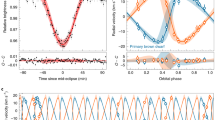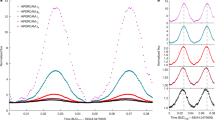Abstract
Brown dwarfs are considered to be ‘failed stars’ in the sense that they are born with masses between the least massive stars (0.072 solar masses, M⊙)1 and the most massive planets (∼0.013M⊙)2; they therefore serve as a critical link in our understanding of the formation of both stars and planets3. Even the most fundamental physical properties of brown dwarfs remain, however, largely unconstrained by direct measurement. Here we report the discovery of a brown-dwarf eclipsing binary system, in the Orion Nebula star-forming region, from which we obtain direct measurements of mass and radius for these newly formed brown dwarfs. Our mass measurements establish both objects as brown dwarfs, with masses of 0.054 ± 0.005M⊙ and 0.034 ± 0.003M⊙. At the same time, with radii relative to the Sun's of 0.669 ± 0.034R⊙ and 0.511 ± 0.026R⊙, these brown dwarfs are more akin to low-mass stars in size. Such large radii are generally consistent with theoretical predictions for young brown dwarfs in the earliest stages of gravitational contraction4,5. Surprisingly, however, we find that the less-massive brown dwarf is the hotter of the pair; this result is contrary to the predictions of all current theoretical models of coeval brown dwarfs.
This is a preview of subscription content, access via your institution
Access options
Subscribe to this journal
Receive 51 print issues and online access
$199.00 per year
only $3.90 per issue
Buy this article
- Purchase on Springer Link
- Instant access to full article PDF
Prices may be subject to local taxes which are calculated during checkout



Similar content being viewed by others
References
Chabrier, G. & Baraffe, I. Theory of low-mass stars and substellar objects. Annu. Rev. Astron. Astrophys. 38, 337–377 (2000)
Burrows, A., Hubbard, W. B., Lunine, J. I. & Liebert, J. The theory of brown dwarfs and extrasolar giant planets. Rev. Mod. Phys. 73, 719–765 (2001)
Basri, G. Observations of brown dwarfs. Annu. Rev. Astron. Astrophys. 38, 485–519 (2000)
Baraffe, I., Chabrier, G., Allard, F. & Hauschildt, P. H. Evolutionary models for solar metallicity low-mass stars: mass-magnitude relationships and colour-magnitude diagrams. Astron. Astrophys. 337, 403–412 (1998)
D'Antona, F. & Mazzitelli, I. Evolution of low mass stars. Mem. Soc. Astron. It. 68, 807–822 (1997)
Zapatero Osorio, M. R. et al. Dynamical masses of the binary brown dwarf GJ 569 Bab. Astrophys. J. 615, 958–971 (2004)
Andersen, J. Accurate masses and radii of normal stars. Astron. Astrophys. Rev. 3, 91–126 (1991)
Wilson, R. E. & Devinney, E. J. Realization of accurate close-binary light curves: application to MR Cygni. Astrophys. J. 166, 605–620 (1971)
Prsa, A. & Zwitter, T. A computational guide to physics of eclipsing binaries. I. Demonstrations and perspectives. Astrophys. J. 628, 426–438 (2005)
Chabrier, G., Baraffe, I., Allard, F. & Hauschildt, P. Evolutionary models for very low-mass stars and brown dwarfs with dusty atmospheres. Astrophys. J. 542, 464–472 (2000)
Scholz, A. & Eisloffel, J. Rotation and variability of very low mass stars and brown dwarfs near epsilon Ori. Astron. Astrophys. 429, 1007–1023 (2005)
Mohanty, S. & Basri, G. Rotation and activity in mid-M to L field dwarfs. Astrophys. J. 583, 451–472 (2003)
Stassun, K. G., Mathieu, R. D., Vaz, L. P. R., Stroud, N. & Vrba, F. J. Dynamical mass constraints on low-mass pre-main-sequence stellar evolutionary tracks: an eclipsing binary in Orion with a 1.0 M⊙ primary and a 0.7 M⊙ secondary. Astrophys. J. Suppl. 151, 357–385 (2004)
Bessell, M. S. The late-M dwarfs. Astron. J. 101, 662–676 (1991)
Slesnick, C. L., Hillenbrand, L. A. & Carpenter, J. M. The spectroscopically determined substellar mass function of the Orion Nebula cluster. Astrophys. J. 610, 1045–1063 (2004)
Hillenbrand, L. A. & White, R. J. An assessment of dynamical mass constraints on pre-main-sequence evolutionary tracks. Astrophys. J. 604, 741–757 (2004)
Carpenter, J. M., Hillenbrand, L. A. & Skrutskie, M. F. Near-infrared photometric variability of stars toward the Orion A molecular cloud. Astron. J. 121, 3160–3190 (2001)
Genzel, R. & Stutzki, J. The Orion molecular cloud and star-forming region. Annu. Rev. Astron. Astrophys. 27, 41–85 (1989)
Sicilia-Aguilar, A. et al. Accretion, kinematics, and rotation in the Orion Nebula Cluster: Initial results from Hectochelle. Astron. J. 129, 363–381 (2005)
Hillenbrand, L. A. On the stellar population and star-forming history of the Orion Nebula Cluster. Astron. J. 113, 1733–1768 (1997)
Palla, F. & Stahler, S. W. Star formation in the Orion Nebula Cluster. Astrophys. J. 525, 772–783 (1999)
Pont, F. et al. A planet-sized transiting star around OGLE-TR-122. Accurate mass and radius near the hydrogen-burning limit. Astron. Astrophys. 433, L21–L24 (2005)
Reipurth, B. & Clarke, C. The formation of brown dwarfs as ejected stellar embryos. Astron. J. 122, 432–439 (2001)
Bate, M. R. & Bonnell, I. A. The origin of the initial mass function and its dependence on the mean Jeans mass in molecular clouds. Mon. Not. R. Astron. Soc. 356, 1201–1221 (2005)
Bate, M. R., Bonnell, I. A. & Bromm, V. The formation mechanism of brown dwarfs. Mon. Not. R. Astron. Soc. 332, L65–L68 (2002)
Maxted, P. F. L. & Jeffries, R. D. On the frequency of close binary systems among very low-mass stars and brown dwarfs. Mon. Not. R. Astron. Soc. 362, L45–L49 (2005)
Mohanty, S., Jayawardhana, R. & Basri, G. Measuring fundamental parameters of substellar objects. II. Masses and radii. Astrophys. J. 609, 885–905 (2004)
Mohanty, S. et al. Measuring fundamental parameters of substellar objects. I. Surface gravities. Astrophys. J. 609, 854–884 (2004)
Doppmann, G. W. & Jaffe, D. T. A spectroscopic technique for measuring stellar properties of pre-main-sequence stars. Astron. J. 126, 3030–3042 (2003)
Doppmann, G. W., Jaffe, D. T. & White, R. J. Stellar properties of pre-main-sequence stars from high-resolution near-infrared spectra. Astron. J. 126, 3043–3057 (2003)
Acknowledgements
We are grateful to I. Baraffe, G. Basri, D. Golimowski, and D. Weintraub for discussions, and to D. Gudehaus and A. Prsa for software used in our analyses. This work is supported by grants to K.G.S. and R.D.M. from the National Science Foundation. The Gemini Observatory is operated by the Association of Universities for Research in Astronomy, Inc., under a cooperative agreement with the NSF on behalf of the Gemini partnership: the National Science Foundation (USA), the Particle Physics and Astronomy Research Council (UK), the National Research Council (Canada), CONICYT (Chile), the Australian Research Council (Australia), CNPq (Brazil), and CONICET (Argentina).
Author information
Authors and Affiliations
Corresponding author
Ethics declarations
Competing interests
Reprints and permissions information is available at npg.nature.com/reprintsandpermissions. The authors declare no competing financial interests.
Supplementary information
Supplementary Figure 1
The geometry of the orbit is shown both as it appears from Earth and as it would appear if seen from above, at four different times in the orbit. Also shown is the relationship between the orbital geometry and the diminutions of light that occur when the brown dwarfs eclipse one another. (PDF 142 kb)
Rights and permissions
About this article
Cite this article
Stassun, K., Mathieu, R. & Valenti, J. Discovery of two young brown dwarfs in an eclipsing binary system. Nature 440, 311–314 (2006). https://doi.org/10.1038/nature04570
Received:
Accepted:
Published:
Issue Date:
DOI: https://doi.org/10.1038/nature04570
This article is cited by
-
Weighing stars from birth to death: mass determination methods across the HRD
The Astronomy and Astrophysics Review (2021)
-
An eclipsing substellar binary in a young triple system discovered by SPECULOOS
Nature Astronomy (2020)
-
Brown dwarf characterization with EChO
Experimental Astronomy (2015)
-
Surprising dissimilarities in a newly formed pair of ‘identical twin’ stars
Nature (2008)
-
Astrophysics in 2006
Space Science Reviews (2007)
Comments
By submitting a comment you agree to abide by our Terms and Community Guidelines. If you find something abusive or that does not comply with our terms or guidelines please flag it as inappropriate.



